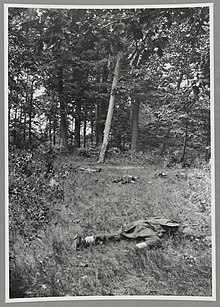
Back Fotógrafos de la Guerra de Secesión Spanish Fotografi della guerra di secessione americana Italian



The American Civil War was the most widely covered conflict of the 19th century. The images would provide posterity with a comprehensive visual record of the war and its leading figures, and make a powerful impression on the populace. Something not generally known by the public is the fact that roughly 70% of the war's documentary photography was captured by the twin lenses of a stereo camera.[3] The American Civil War was the first war in history whose intimate reality would be brought home to the public, not only in newspaper depictions, album cards and cartes-de-visite, but in a popular new 3D format called a "stereograph," "stereocard" or "stereoview." Millions of these cards were produced and purchased by a public eager to experience the nature of warfare in a whole new way.[4]
- ^ Although not proven this picture may have been taken by the same photographer who took the alleged "Confederate Dead on Matthews Hill" picture that follows
- ^ Illustrated in: Frassanito, William A., E474.65.F7 (P&P) Antietam: The Photographic Legacy of America's Bloodiest Day, E474.65.F7 (P&P). New York: Charles Scribner's Sons, p. 31, with comments on pages 30-32
- ^ "Blue & Gray in Black & White", Zeller, Bob, 2005 Introduction xvi
- ^ "CCWP". Center for Civil War Photography, John Richter's 3-D Anaglyph Photographs Exhibit. Archived from the original on November 16, 2015. Retrieved November 24, 2015.